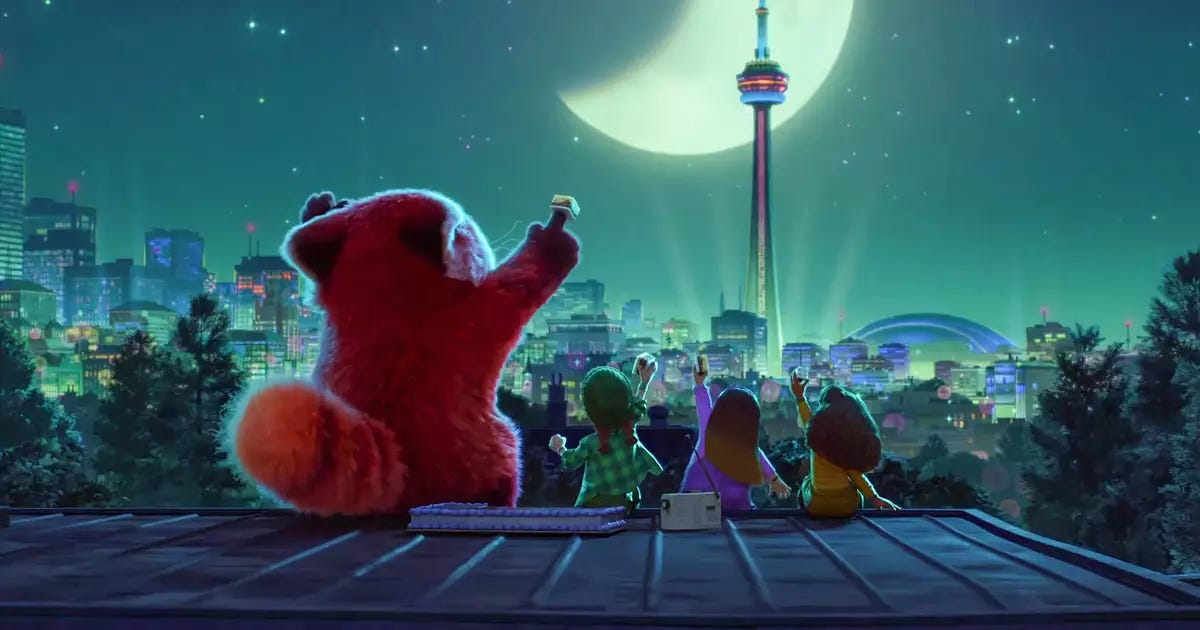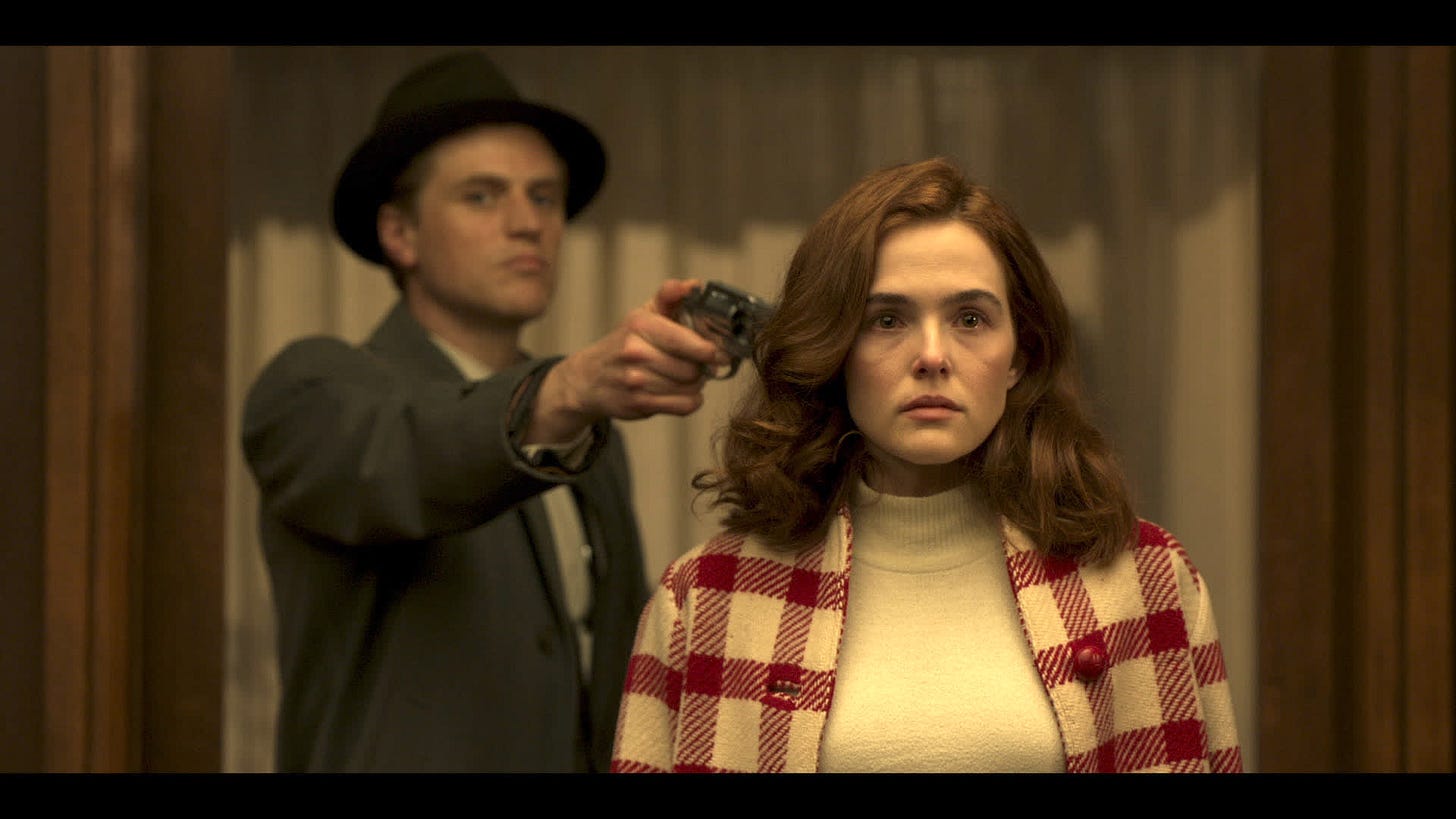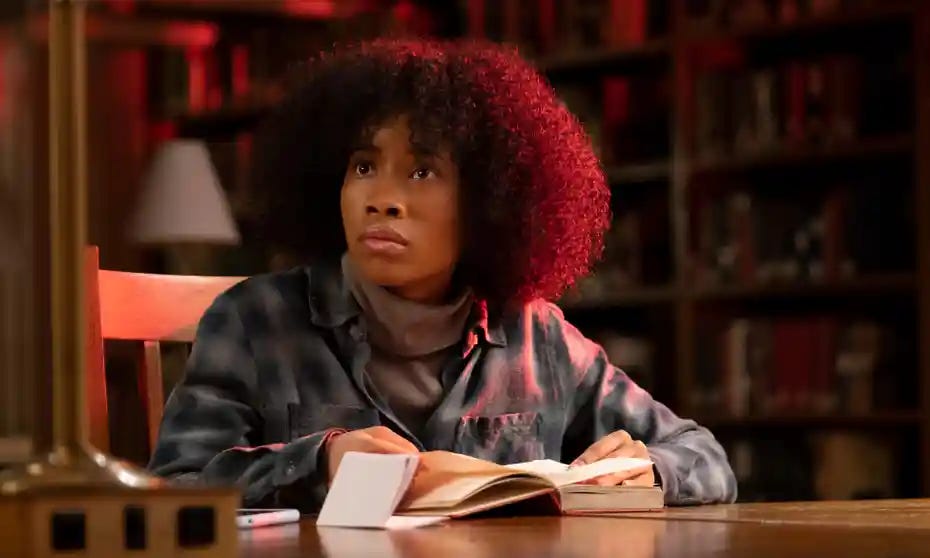New Release Friday: "Turning Red," "The Outfit," & "Master"
Pixar strikes again, Mark Rylance rules, and Regina Hall takes on white academia.
The Nut Graf: Pixar gets its groove back with “Turning Red” (on Disney+, ***1/2 out of ****). “The Outfit” (in theaters, *** stars out of ****) is a field day for the great Mark Rylance. “Master” (in theaters and on Amazon Prime, ** stars out of ****) is a post-“Get Out” thriller where the message is stronger than the method.
“Turning Red” may be the most bizarre movie Pixar has ever made, which is saying something when the competition includes the movie about the gourmet rat and the one set in Mexico’s Land of the Dead. Thankfully, it’s also one of the better Pixars, a distinct upturn from formulaic recent releases like “Onward” and “Luca.” So why did it go straight to the Disney+ streaming service without first stopping at theaters? Is it because the suits thought a movie about a Chinese-Canadian girl, made by a Chinese-Canadian director, was too “niche” for general theatrical release? Or is it because it’s about female puberty, metaphorically and otherwise? (This has caused some mildly outraged carping from more prurient parents, but, trust me, there’s nothing here unsuitable for any child over the age of six.) Regardless of where you see “Turning Red,” it’s delightful, creative, and often laugh-out-loud funny. And like the best Pixars, you don’t need to have a kid to see it. It’s excellent entertainment for grown-up people, too.
Granted, it helps to have known a 13-year-old girl, or to have been one in all her melodramatic middle-school glory. Meilin Lee (voiced by Rosalie Chiang) starts “Turning Red” as a super-confident grade-A student and fairly annoying Miss Perfect whose parents (Sandra Oh as mother Ming and Orion Lee as father Jin) run the oldest family temple in Toronto as a tourist attraction. Mom is a bit of a Tiger Mother – all right, more than a bit – but Meilin is happy to go along until one day she starts changing. Literally. Into a giant, fuzzy red panda. There’s this ancient curse, see, that affects the family’s women as soon as they hit puberty and before they take part in a ceremony that bottles the panda back up where it belongs. Before her ceremony can happen, Meilin will just have to control her emotions if she wants to retain her human form. If you’ve ever had a teenage girl around the house, you know how that’s going to turn out.
When she becomes a panda – which is whenever she’s angry or anxious or feeling these … feelings about boys – Meilin is itchy and awkward, knocking lamps over and breaking the furniture every time she turns around. (Sounds like adolescence to me.) With her best friends Miriam (Ava Morse), Priya (Maitreyi Ramakrishnan), and Abby (Hyein Park), Meilin swoons over a boy band called 4-Town, and “Turning Red” manages to both spoof the hormonal absurdities of teen-girl culture and find the dopey joy in them. Mom, of course, thinks the friends are a bad influence and boy bands are for delinquents, and as good girl Meilin begins to heed her rebellious inner (and outer) panda, the movie dramatizes a generational conflict in the accepted manner of modern animated family movies. But because this is Pixar, the accepted and expected become springboards to surprising complexities and even profundities. Especially once Meilin’s fearsome grandmother (Wai Ching Ho) enters the picture and we start to comprehend the pressures her daughter, Ming, experienced as a girl. The dynamics in “Turning Red” are culturally specific, to be sure, but they’re also universal; the movie speaks to everyone, especially mothers and daughters.
But I’m making it sound like an animated group hug when for most of its running time, “Turning Red” is a fine example of high Pixar slapstick, from Meilin’s desperate attempts to hide her transformed state to her unexpected elevation as the school’s literal party animal to a monster-rama finale at a 4-Town stadium concert that had me hooting at the screen. The inventiveness of the comedy makes the film’s serious moments land all the harder, and there are a couple of scenes toward the end that may choke you up with the vividness of their earned emotions. Visually, “Turning Red” is an ingenious fusion of Chinese cultural motifs, Japanese animation styles, and Pixar-ian cartooniness. Thematically, it’s the latest in a wave of plangent animated narratives about the inner lives of girls: “Frozen,” “Inside Out,” “Encanto.” Taken in its totality, it’s simply a charmer.
You are either in abject thrall to Mark Rylance (above), or you’ve never heard of him. There’s actually no other position to take. Whether you discovered him as Thomas Cromwell in TV’s “Wolf Hall,” in his Oscar-winning supporting role in Spielberg’s “Bridge of Spies,” or you’re just mesmerized by the guy with the weird teeth playing the tech CEO in Netflix’s “Don’t Look Up,” you know that Rylance can mesmerize an audience by using the least gestures possible. He is a master of economy; you lean in watching him, so as not to miss a thing. That he’s in virtually every frame of “The Outfit,” a new movie arriving in theaters today, should be cause for celebration.
It's not a great movie, but it’s an interesting and rather rewarding one – a two-room drama set over the course of a single night in 1950s Chicago. Make that a one-shop drama, since the setting is a side-street establishment run by an unassuming British master tailor named Leonard (Rylance). Leonard prefers to be called a “cutter,” and he makes bespoke suits for the Chicago mob and presumably for a legitimate clientele as well. Discreet and trustworthy, he also allows his backroom to serve as a drop box for payments and messages to the local kingpin Roy (Simon Russell-Beale), whose bad-boy son Richie (Dylan O’Brien) is knocking boots with Leonard’s assistant Mable (Zoey Deutch), a neighborhood tootsie desperate to leave the neighborhood behind. The film’s other key player is Francis, Roy’s favorite-son lieutenant and therefore a threat to his real son Richie; Johnny Flynn plays the part with a kind of violent noir bravura while Rylance keeps to himself, and the contrast between the two characters, the two actors, and the two performances is one of the chief pleasures of “The Outfit.” (This is a very British gangland America, by the way, but it’s hard to mind when you have two stalwarts from the Royal Shakespeare Company in Rylance and Russell-Beale, one of England’s best young actors in Flynn (below left), and a show-stopping turn late in the movie by Nikki Amuka-Bird, another RSC vet. Of the key players, only Deutch (below right) is an authentic Yank.
By now you’ve figured out that the title has a double meaning, just as the film contains doubled, then tripled, then quadrupled layers of crisscross. Francis is lethal and smart, but we know the tailor – I’m sorry, the cutter – has something up his impeccably sewn sleeve and the slow tease of revelation goes a long way to helping a viewer overlook the constricted setting. This really is a play that has been shot on film, but you get a front row seat to an actor’s mastery, and Rylance lets a sideways glance, a flickered eyelid, or a misdirecting comment do all of Leonard’s shouting for him. He’s the actor as poker player; I found myself holding my breath, waiting for the tell. “The Outfit” reminded me of a set-bound puzzler like “Sleuth” – we know we’re stuck here for the next 90 minutes or so, and we know who we’re stuck with (or we think we know), and the rest is just theme and variation and the occasional upending of every last one of our assumptions. If this sometimes seems more like traffic management than a movie, the director, Graham Moore, keeps it moving briskly, trusting his taciturn lead actor to set the tone, pace, and moral compass. Rylance is the actor as clockmaker, working with ratchets and cogs and somehow creating something bigger than life.
“Master” is the feature debut of writer-director Mariama Diallo, and while not wholly successful, it makes me hungry to see what she does next. The movie divided opinions at January’s online Sundance Film Festival and comes to theaters and Amazon Prime today; in the tradition of “Get Out,” it mixes horror and suspense with a gimlet-eyed view of race in America. And it has Regina Hall (above), who is always worth your time, as Gail, a new house master at stately Ancaster College. (Diallo went to Yale, the film was shot on the Vassar campus, and the dialogue places the school within driving distance of Boston. I’m going to go out on a limb and say it’s Tufts.) Gail is also Ancaster’s first Black house master, and Diallo tracks her experiences alongside those of Jasmine (Zoe Renee), an incoming freshman at odds with the privileged whiteness of the student majority. Both women have encounters with the supernatural that grow stronger as the film progresses, but it’s never clear exactly who’s haunting who or what the backstory is. The other side of the metaphor is clearer: That the ghosts of America’s racist past are alive and well beneath the floorboards and behind the painted portraits of Ancaster’s WASPy forebears, and anyone who says otherwise is naïve or bucking for tenure.
Hall and Renee (below) are both very good, but on the evidence of “Master,” Diallo, who has made several well-received short films, hasn’t yet figured out how to shape and pace a feature. The movie is overstuffed with characters and bumps in the night but shy on connective plot tissue, and late in the going there’s a revelation about a major character – one that could have been ripped from the headlines of six or seven years ago – that seems like one more pick-up stick atop a wobbling pile.
What “Master” does exceedingly well – and it’s worth a look for this alone – is dramatize with a kind of bleak satirical scorn the slights and assumptions and diminutions that come with being a person of color in a complacent white milieu. The word “microaggressions” doesn’t do justice to the endless tiny stings, consciously meant or not, that remind Gail and Jasmine of exactly how much they don’t belong here. Adding a supernatural element may have helped Diallo get her movie bankrolled in post-“Get Out” Hollywood, but her skill set may lie more with the social dramas on this side of the paranormal. As I said, watch this space.
If you enjoyed this edition of Ty Burr’s Watch List, please feel free to share it with friends.
If you’re not a paying subscriber and would like to sign up for additional postings and to join the discussions, here’s how:
If you’re already a paying subscriber, I thank you for your generous support.










